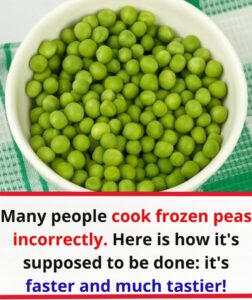Most People Ruin Frozen Peas — Here’s the Quick and Proper Way to Cook Them for Maximum Flavor

Frozen peas are one of the simplest veggies to keep on hand—but surprisingly, they’re often prepared the wrong way. The result? Dull color, mushy texture, and barely any flavor.
What’s the biggest mistake? Tossing them directly into boiling water without a second thought. This common habit can actually strip them of their natural sweetness, bright green color, and valuable nutrients.
Let’s break down how to cook frozen peas the right way—so they stay fresh-tasting, vibrant, and delightfully tender.
Why Frozen Peas Need Special Care
Unlike meat or fish, frozen peas don’t need thawing before cooking. But that doesn’t mean you can just throw them in a pot and hope for the best.
Here’s what to do instead:
-
Bring a pot of water to a boil.
-
Toss in a pinch of salt—and for an extra boost of green, add a dash of baking soda.
-
Add your peas straight from the freezer (no thawing needed!).
-
Let them cook for just 2 to 4 minutes, depending on how firm or soft you like them.
-
Immediately drain and rinse with cold water or plunge them into an ice bath to stop the cooking and lock in their texture.
This quick-cook method prevents sogginess and keeps them looking and tasting like they were just picked from the garden.
Cooking with Peas? Timing Is Everything
If you’re making a stir-fry, stew, or rice dish, don’t throw peas in too early. They’re already partially cooked during the freezing process, so they only need to be warmed through.
🔸 Best practice: Stir them in about 3 to 5 minutes before the dish is done. This keeps their natural snap and sweetness intact.
And if you want them to shine even more, sauté them gently in butter or olive oil. Keep the heat at medium and stir occasionally. This approach draws out their delicate flavor and prevents that dreaded sogginess from too much steam.
Bonus Tricks for Next-Level Peas
-
🍬 A pinch of sugar can highlight their natural sweetness—especially in side dishes or salads.
-
🌿 Pair with mint or fresh herbs for a refreshing twist.
-
🔁 Don’t reheat more than once. Peas are best fresh and lose quality quickly with each round of warming.
-
💧 Use just enough boiling water to cover them—no more.
-
🍋 Skip acidic ingredients like lemon or vinegar during cooking—they can dull both the flavor and the color. If needed, add them right before serving.
The Bottom Line
Peas are easy—but they deserve a little finesse. By cooking them quickly, avoiding over-steaming, and adding them at the right moment in recipes, you’ll get tender, sweet, and delicious results every single time.
Sometimes, it’s the smallest tweaks in your kitchen routine that make the biggest difference on the plate.